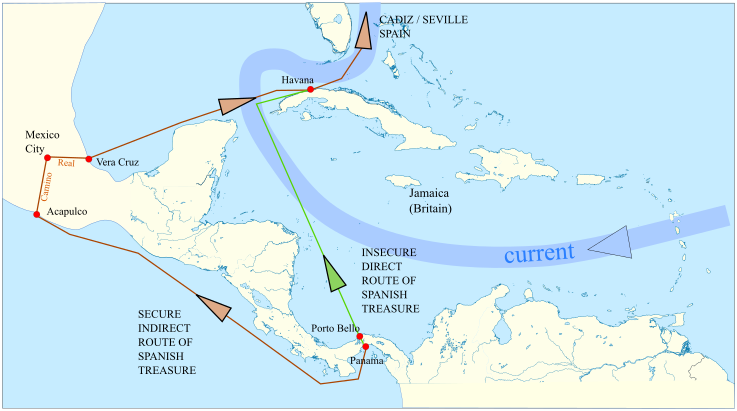Image: Map WestIndies SpanishTreasureRoutes 1726

Description: Map showing alternative sailing routes used by the Spanish circa 1726 to export their Southern American gold back home to Cadiz, Spain. The procedure was always at great risk of attack by pirates or by the fleets of foreign nations and great stealth and speed had to be practiced. Before the w:Blockade of Portobello by the British fleet, Viscount Townshend, Secretary of State, received a report from Woods Rogers and Capt. Jonathan Denniss, both experts on the topic, advising him on the stealthy routes taken by spanish gold ships for evading detection. A report dated 10 November 1726 was delivered to prepare Admiral Hosier for his task.[1] "My Lord, According to what your lordship was pleased to command us, we have considered the account given by Mr Cayley from Cadiz to his grace the Duke of Newcastle of three men-of-war and a ship of ten guns being sent under the command of Admiral Castanetta from that port in the month of May last, with canon and land forces which, your lordship apprehends, may be ordered round Cape Horn, in order to bring to Spain the bullion now detained at Panama, and we give it your lordship as our opinion, that it is not only improbable, but almost impracticable, for the following reasons: First because of the time of year in which those ships sailed from Cadiz, which is at least three months to soon to attempt getting round Cape Horn, or through the Straits of Magellan, especially if the nature of the ships be considered, and their being deeply laden, and having canon and land forces on board. Secondly, because there can be no need of canon in Peru or Chile, those provinces abounding in metal for casting them, and the Spaniards being able to do it (as they always have done) cheaper and full as well as in Spain, and as to the soldiers, the transporting them that way seems altogether improbable because of the many better methods there are of doing it. Thirdly, my Lord, as the bullion is now at or near Panama, the embarking it thence to Lima, and so to be brought round Cape Horn, will require so prodigious an expense both of time and money, that renders the doing of it extremely improbable. 'Tis true, my Lord, were the money now at Potosi or Lima 'twould be easy enough to bring it round Cape Horn, or rather overland to Buenos Aires, where Castanetta might be gone to receive it, but as it is not, the bringing of it from Panama to Lima will require too long a time, because of the difficulty of the navigation from the former to the latter place, being against both winds and currents, so that the Spanish ships are commonly from six to eight or ten months performing the voyage, and though the French formerly often came with their money round the Cape to France, yet your Lordship will consider their tract of trade was never to leeward, or to the northward of the coasts of Peru, by which means the greatest fatigue of the voyage was avoided. But, my Lord, what seems to us the most likely is that Castanetta after refreshing at the Havana, may go to La Vera Cruz, and there wait for the bullion from Panama (from whence it may be sent to La Vera Cruz under a notion of its being re-shipped for Peru) and so bring it to Havana there to join the Flota, and so come for Spain (or send it home in running ships[2] and our reason for this suggestion is not only for the above difficulties that must and will attend bringing the bullion now at Panama to Spain, round Cape Horn, or by the way of Buenos Aires, but because of the facility and dispatch with which it may be transported from Panama to Acapulco, and so by land to La Vera Cruz, which is what has been often practised by the Spaniards, even when there was no blockade at Porto Belloo nor fear of enemies (as a conveniency for Spain has offered), for the navigation from Panama to Acapulco is very safe and easy, and the carriage from thence to La Vera Cruz is neither so difficult nor expensive as that between Lima and Buenos Aires. This, my Lord, is what occurs to us worthy your Lordship's notice. We are, with the uttermost respect and submission My Lord, Your Lordship's most devoted and most obedient humble servants, Woodes Rogers. Jonath. Denniss". The road between the ports of Acapulco and Veracruz and passing through Mexico City was called the Camino Real ("royal road") and is reputed to have witnessed the largest transfer of riches in the history of mankind.[1][2]
Title: Map WestIndies SpanishTreasureRoutes 1726
Credit: Map amended from File:Caribbean location map.svg by User:Milenioscuro
Author: Lobsterthermidor (talk) 19:13, 28 October 2020 (UTC)
Usage Terms: Creative Commons Attribution-Share Alike 3.0
License: CC BY-SA 3.0
License Link: https://creativecommons.org/licenses/by-sa/3.0
Attribution Required?: Yes
Image usage
The following page links to this image:

